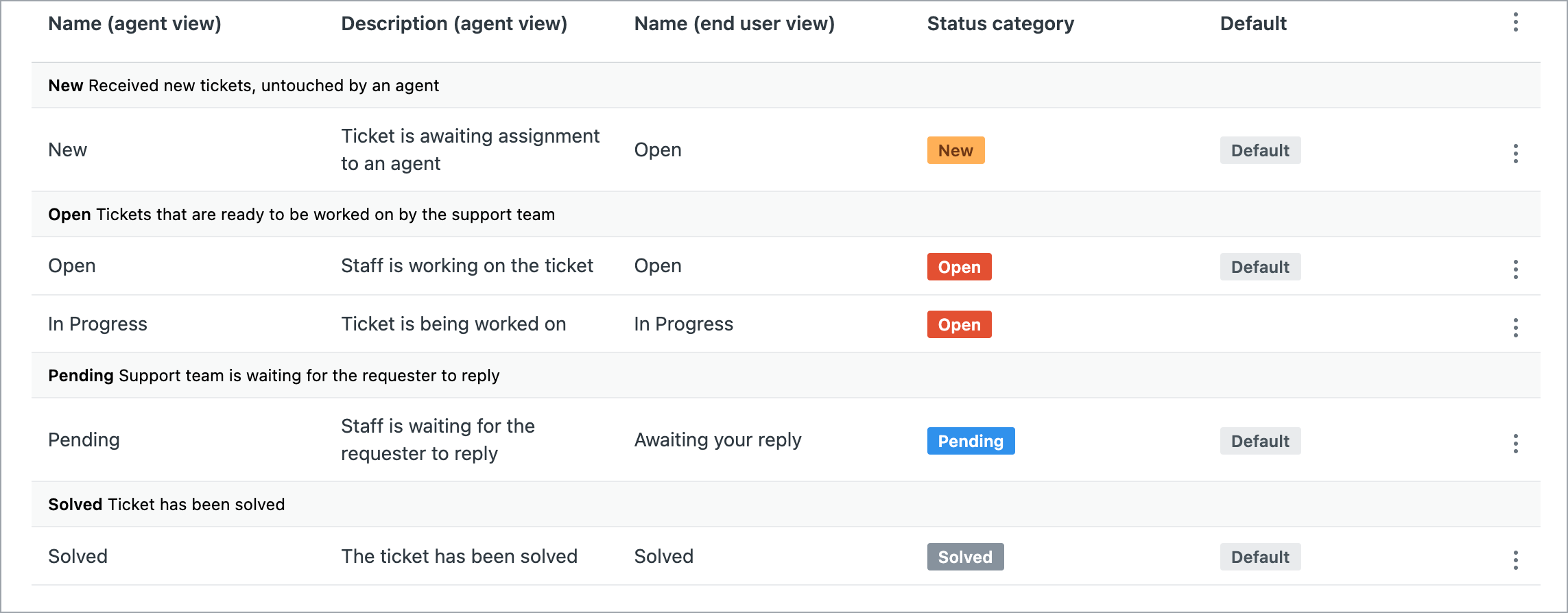
Click Follow in the What's New section to be notified each month when the What's New is published.
Check out what's new in the last month:
- Support
- Zendesk Suite
- Bots and automation
- Explore
- Guide
- Security
- Messaging
- Workforce management
- Talk
- New and notable content
Also don't miss:
Support
-
An additional ticket status, In Progress, is included in the Open status category for accounts created on or after Feb 13, 2024. This status is included as an example of a custom ticket status but it can still be applied to tickets, edited, or deactivated like other ticket statuses. See Managing ticket statuses.

For accounts created before Feb 13, 2024, the In Progress status isn't automatically included but you can create it manually. - The data importer can now perform bulk updates to existing organizations and custom object records in addition to creating new organizations and custom object records. At this time, you must choose whether your performing a bulk creation of new records or a bulk update to existing records. See About the data importer.
- A new pre-trained intent model tailored to the travel, hospitality, and tourism industry is available for use with intelligent triage and advanced bots. Intents offer automated and consistent classification of incoming tickets and conversations, which can be leveraged in business rules, workflows, routing, and more. See About intelligent triage and About advanced bots.
Zendesk Suite
-
Zendesk Suite customers can buy additional light agent seats as needed. Previously, you were limited to a certain number of light agents depending on your plan type. Self-service or online-assisted accounts can buy light agents directly from Admin Center. Customers with managed accounts can contact an account representative or Zendesk Sales to buy more seats. See Buying light agents.

Bots and automation
-
Consolidated bot settings make it easier for admins to access all configurable settings in a bot. General and language settings are now accessed via a tab on the bot's edit page. See Viewing and editing general bot settings and Managing languages in a conversation bot.

- Custom ticket fields are available in the transfer to agent step in bot builder. This helps provide agents more context about the customer and their problems. See Understanding answer step types.
- Answer cloning can be used to copy a complete answer within a bot or to another bot. See Managing answers in a conversation bot.
Explore
-
Admins can now change the status of a single agent or multiple agents directly from the agent list in the Agent workload vs. capacity window. This allows for better management and more accurate representation of agent availability. See Changing agent status.

Guide
- You can use HTML blocks to work with advanced HTML code and scripts in content blocks. With HTML blocks, you can include HTML elements in the content block editor. Any JavaScript or CSS in the HTML block has access to the entire article.

You can click the block to open a source code editor that displays only the code for that block, making it easier to edit and work with the code. See Using HTML blocks to edit code in content blocks.
Security
-
You can create a deletion schedule to delete archived tickets in bulk. Deletion schedules allow you to establish data retention policies, manage your data storage, and comply with global privacy regulation. See Creating ticket deletion schedules for data retention policies.
Messaging
- The Zendesk SDK for Unity with messaging is now available for everyone. This updated version of the mobile gaming SDK includes our bot builder tool, which means you can build automated conversation bots in minutes. See Working with messaging in your mobile channel and our developer documentation for Unity.
- Authenticating end users using signed email. You can now use a combination of an external id and an email address to uniquely identify end users. Developers will need to include a new email_verified claim in issued JWTs. See Using email identities to authenticate end users for messaging and Enabling authenticated visitors for messaging with Zendesk SDKs.
Workforce management
- Tymeshift, Zendesk's workforce management (WFM) solution, strengthened its integration with Zendesk by introducing a new set of features. Learn more about Tymeshift's improved capabilities.
- Log in to your Tymeshift web app directly from your Zendesk account using the new Tymeshift log in experience. See Logging in to Tymeshift.
- Additional filtering options are available on the Agent attendance page in Tymeshift. These filters help managers organize their view of agents' attendance. See About the Agent attendance page.
Talk
- Agents can now filter their outbound line when placing calls. Searching for a specific line by name, number, or brand, makes it easier and faster to select the right line. This is a significant improvement if you have many lines. See Making outbound calls.
New and notable content
- Deploying an update to a trigger from a premium sandbox to production. A new workflow recipe that walks through the experience of modifying trigger conditions and actions to incorporate a new group. See Workflow recipe: Deploying an update to a trigger.
- Best practices for boosting agent productivity with AI features. A new article summarizes the generative AI features for agents and describes which types of teams and situations each feature is most useful for. See Best practices for boosting agent productivity with AI features.